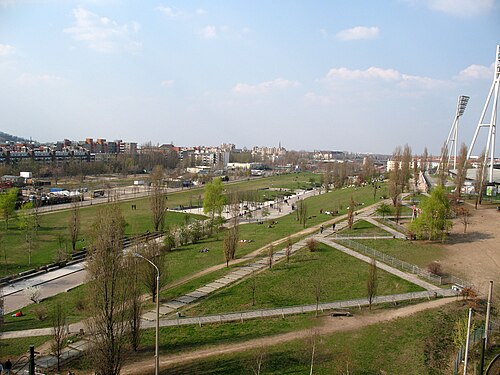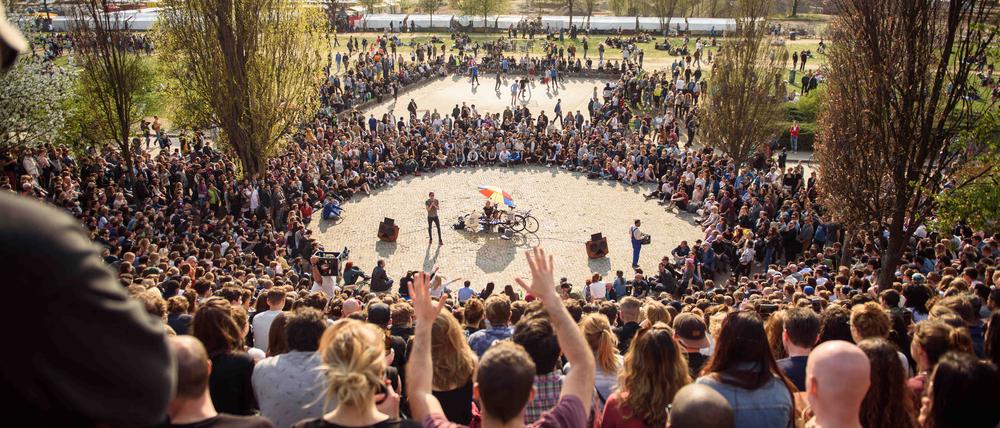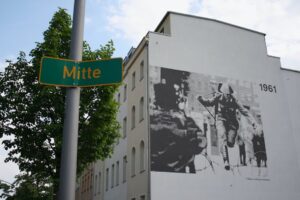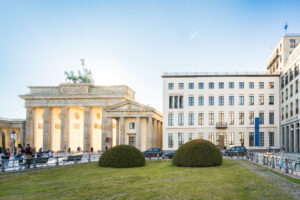Picture a place where you can play football, browse a flea market, catch a live sporting event, and enjoy a barbecue all in one day. This probably wasn’t too much of a task, you very likely just imagined your local park. But now, imagine doing all of this on the very ground where two bitterly hostile worlds were once separated by a «death strip» where guards in grey uniforms had order to shoot to kill on sight.
This stark contrast is something you can see in Berlin, at the iconic Mauerpark.
How to Get There?
You can approach this unique place from any number of directions, but let’s assume that you’re approaching it from the west. In other words, let’s imagine that like most visitors you’ll have just visited the fascinating set of outdoor displays the mark the city’s official Berlin Wall Memorial on Bernauerstrasse. You can best start your visit by getting off the S-Bahn at Nordbahnhof and walking along the reconstructed section of the Wall that looms up in front of you as you exit.
Your walk along the Memorial will probably put you in the right contemplative frame of mind for your upcoming encounter with the Mauerpark. Here history, and history beyond just the Cold War, will swirl around you, but it will take some unpacking as the area has changed a lot over the decades.
I suggest, after leaving the outdoor exhibits of the official Wall memorial behind, you cross over Bernauerstrasse and walk East (the same way you probably have been walking), but now on the northern side of the street. The Wall continued here, though all traces have now long gone. Within about 7 to 10 minutes, you should see the park loom up to your left. You’ve arrived.
The former Heavy Goods Station
The first thing to look out for are a set of slightly oddly out-of-place brick pillars that look like they once might have been gates of some sort. You’re right in that impression, for these are all that’s left of the old Northern Railroad’s Heavy Goods Station. Built in the time of the Kaiser, this station carried freight from northern Berlin to destinations north and northeast. In both the First and Second World Wars, they helped keep the German armies on the move.
While we’re on the topic of train stations, have a quick look at your map. You’ll see that you’re standing on the lower left edge of the long rectangular Mauerpark. The shape of the park is no accident. As a general rule, when you see long rectangular parks in Berlin, you’re almost certainly standing in a former train station or, as here, a heavy goods station. This one was badly damaged in the war, but managed to limp on with limited service until the later Cold War era, before being shut down completely.
Where the Wall Stood – and Turned
Don’t yet enter the park. Instead, continue walking on the street and within a minute or two you’ll see the by now familiar line of bricks announcing the former presence of the Berlin Wall. Incidentally, if you can read the words on the memorial plaque normally, i.e. they are the correct side up for reading, then you’re standing in the west. If the words are upside-down, you’re in the former east. This element has been seen by some as a subtle snub to the former DDR and contributed in a small way to the ongoing debates raging about the legacy of the DDR (East Germany) and the place that failed state has in the official memory of Germany at large. Here you can glimpse a sliver of that conflicts that still rage over questions about who owns the past, who gets to decide how the past is remembered and why.

However, the most interesting point in this location is that the wall has, in fact, turned 90 degrees and crossed the road. That insight is the key to understanding the layout of the park. The Wall turned, it’s not you being confused or lost. To help orient yourself, carry on walking straight until you get to a small memorial containing some remains of the former security structure (rusting iron set in old concrete) and some very useful information boards with period photographs. Stay and absorb these images; they provide not just orientation but also a crucial insight into how this place looked during those dark cold war years.
Entering the Park
You can now enter the park. Look down the length of it. On the left, you’ll see some buildings housing a modern flea market, with operates on the weekends. This long length was in the west. You’re standing more or less on the line of the wall now. On the right was the death strip, which ran all the way up to the stadium on the hill. This part on your right was therefore East Berlin.
The Hill and the Stadium
You can walk uphill to the Jahn stadium, or stay low and walk along the length of the park. Take note of the hill; it’s not a natural feature. The hill is made up of the many thousands of tons of brick and stone that was once the city’s local buildings. This is nothing less than a massive hill of war ruins, the former Berlin, as it were. It’s a shocking reminder of just how much was destroyed.
On the hill, you’ll see the remains of the «back wall,» that is to say, the second smaller wall that sealed off the secure zone, thereby forming the death strip. Today it’s dedicated to street art. The stadium you see today was built in the early 1950s and played host to the III World Festival of Youth, a showcase communist project that allowed the newly formed East Germany to posture as a promoter of international understanding and world peace. It was a huge hit and showed the communists in the glowing light they earnestly hoped to be seen in.

The spot the stadium sits on was, a century before the festival, a Prussian military parade ground. It was later turned into a football pitch, which makes this piece of earth Germany’s longest established football grounds, having been going continuously (apart from when the war ruins were dumped on the field) since the late 1880s. You’ll notice that the back wall and the security zone butt right up against the wall of the stadium; sport and pleasure rubbing shoulders with fear and prohibition. Some might say a very German 20th century story. It’s a darkly poetic place.
The Prussian Underpass on Gleimstrasse
Down below on ground level you’ll find a little stage area for karaoke. Best avoided, in my view, unless you have ears made of iron. If you carry on straight, after a good five-minute walk you’ll come to a street called Gleimstrasse. To your left is a viaduct, where the road crosses under the former tracks which used to sit above. You’re looking here at one of two surviving Kaiser-era underpasses, with beautifully wrought iron column capitals. Linger for a moment to take a closer look, and you’ll feel an echo of the elegance of that lost old world.
The reason this place survived so well is that it was in the death strip. The back wall ran along the east end of the road, where you’re standing, and West Berlin started somewhere about two-thirds of the way through the tunnel. Such were the absurdities of the era.

This area also saw heavy fighting in the closing days of the war, and you might also find the odd bullet hole still lingering. And that wraps up your visit here. The Mauerpark, including this once desolate underpass, weaves together stories of industry and sport, of war and division. Today, the streets echo with laughter, yet here in Berlin, there’s always a deeper layer. Beneath the surface, the tale turns darker—and far more intriguing.




